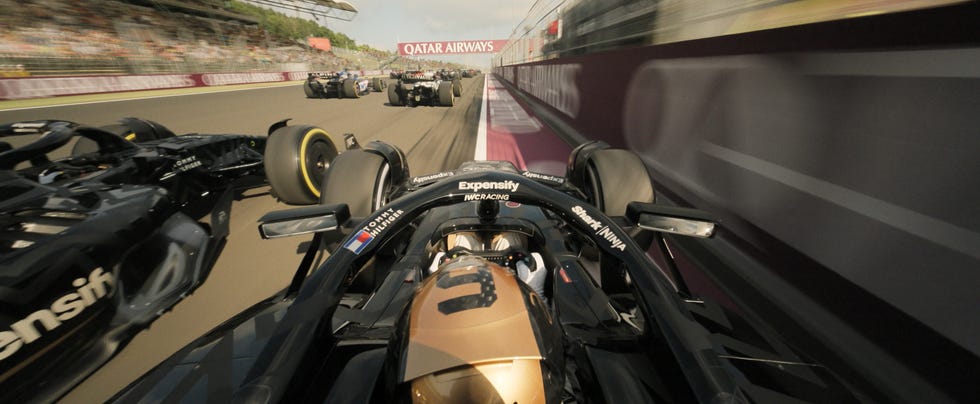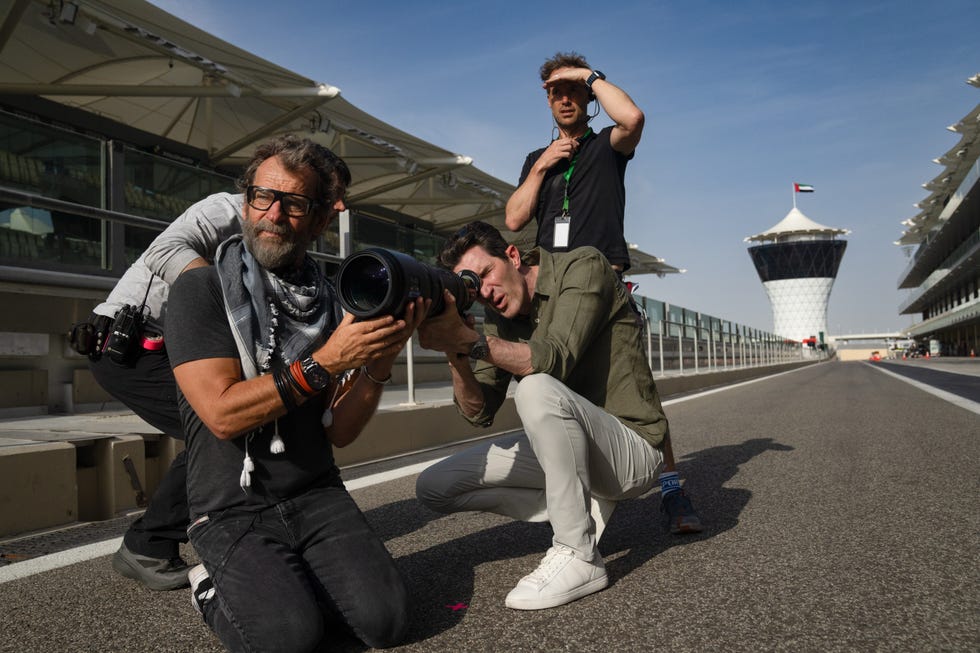We Asked the <em>F1</em> Cinematographer All Your Burning Questions

Most summer blockbusters offer an escape from the heat—but only one movie makes you feel like you're right in the middle of it. F1: The Movie, directed by Joseph Kosinski and starring Brad Pitt as a professional Formula 1 driver, is still making laps in theaters, thanks to its breakneck thrills and feels-like-you're-there immersion. If you left F1 feeling winded as though you really went 220 miles an hour in Monaco, well, that was the goal. So says F1 cinematographer Claudio Miranda.
"Like Top Gun, we wanted a visceral experience," Miranda tells me.
Miranda started in Hollywood as a gaffer for David Fincher, working on the director's acclaimed thriller Seven. He spent the first half of the 2000s shooting music videos for Sisqó (he shot the more risqué, non-MTV version of "Thong Song"), Backstreet Boys, and Beyoncé until 2006, when the rom-com Failure to Launch marked his debut as a theatrical cinematographer. In 2010, Miranda teamed up with Joseph Kosinski on Tron: Legacy, kicking off a decades-long partnership that includes the 2022 epic Top Gun: Maverick. Miranda also shot Ang Lee's Life of Pi, for which he won the Oscar for Best Cinematography. Ninety years from now, more of his work will surface in 100 Years, an experimental short commissioned by Rémy Martin that will be released in the year 2115.
F1: The Movie marks yet another project with Miranda as Kosinski's director of photography. The movie tells of a veteran racer (Pitt) who is invited by an old friend to help a bottom-rung Formula 1 team win the F1 World Championship. Filming took place at real Grand Prix weekends during the 2023 and 2024 World Championships. More than a dozen fist-sized cameras, made exclusively for F1, were placed on modified Formula 2 cars that the actors drove for real at famous circuits like Silverstone (in England), Hungaroring (in Hungary), Las Vegas Strip Circuit (in Nevada), and Yas Marina (in Abu Dhabi).
Miranda and the production team went to these lengths in service of two goals. The first was to make audiences see for themselves that Brad Pitt and Damson Idris seriously drove at close-to-real Formula 1 speeds—no green screen, no trickery, no foolery. The second was to create a big-screen spectacle built on speed and authenticity.
"That's what bothered me," says Miranda, who was dissatisfied with what other racing movies have done. "I got tired every time you went inside a car. It looked slow, or they're doing speed-up tricks. I'm not saying we didn't do any, but I just feel that looks fake."
On other productions, the use of a process trailer—which can be as long as 26 feet and around 7,500 pounds—lets actors stay focused on their performance while their characters drive. But because they reach a max speed of only 60 miles an hour, if that, they were out of the question for F1, which strove to simulate the thrill of 230-miles-per-hour-races. "My process car was never going to work," says Miranda.
It wouldn't have felt right to lean on modern technology either. "If you want to do the virtual-reality version, that's a super sad movie. Joe [Kosinski] and I feel the audience is smart enough to know the difference [between simulated racing and real racing]. It was really important to get Brad and Damson going 180 miles an hour. We thought that's something people want to see. ... People want to be at real races. That's what makes this movie stand apart from other racing movies."
So how did F1 get people believing they can feel the wind at the Belgian Grand Prix? Their first step was deceptively simple: Get the cameras ready.

For F1, cinematographer Claudio Miranda worked with Sony and Panavision to create the "Carmen," an exclusive small camera that was engineered to fit inside the seats of Formula 2 cars.
For F1, the production team members knew they wanted cameras in the driver seats. The problem is that "most cameras are just too big," says Miranda. They're too bulky to be inside tight race cars, and worse, they obscure the drivers' line of sight. While Pitt and Idris drove at reduced speeds compared with real F1 races—"like 15 percent slower," Miranda estimates—they're still driving around 200 miles an hour. "I approached Sony and said, 'We need to make a camera that's small.' They made 20 [custom] cameras for us."
Using these custom cameras—what Miranda basically calls "sensors on a stick" with most of the electronics gutted and functionality operated remotely—Miranda and the crew succeeded in capturing panoramic views of Pitt and Idris driving on some of the world's most famous race tracks with all kinds of choreographed chaos surrounding them.
"We operated most of the cameras from what we call 'the garage,' " Miranda says, adding that solutions specialists RF Film created the wireless network that allowed them remote control of the cameras. "We had a network around the track that we could see all these things and communicate with actors. We could say to the operators in the garage, 'Pan left' or 'Pan forward.' We had a master command center where I could see all the cameras and feeds. Sometimes we'd be running 12 cameras at a time. We weren't limited by range."
The production had a name for these cameras: Carmen. "It's a funny little joke, because my last name is Miranda. Carmen Miranda. You know, the fruit lady."

Joseph Kosinski, behind the scenes of F1: The Movie.
A shot that occurs throughout F1: The Movie is a sharp 180 degree pan; the camera takes in the spectacle of a crash or collision before panning to a close-up of Brad Pitt or Damson Idris in the cockpit. The intended effect is for you to know for sure the actors weren't simply on a green screen.
"We had Panavision work on a way to pan the cameras," Miranda says. "To show us something amazing, like a car crash, and here's Brad Pitt's reaction to that crash. You can't get it from cutting forward to back. You're saying, Brad's really here. It gives you more believability he's driving than just a close-up. These pans make it feel connected. It's very exciting to see Brad going 200 miles an hour."
Miranda also took some visual inspiration from Formula 1: Drive to Survive, the hit Netflix documentary series that takes audiences deep into the garages of real Formula 1 teams. Occasionally, F1: The Movie feels like a Formula 1 broadcast; that's partially by design, though Miranda remained steadfast in cinema as an art form.
"I watched some Drive to Survive, and I did look at some races in the beginning. We want to improve on everything they did. There's not really a reference for another movie, because we're very unique. We're trying to do something that no one else [is trying to do]."
If you squint watching F1: The Movie and see echoes of Top Gun: Maverick, that's not entirely a mistake. Both Kosinski and Miranda reapplied Top Gun's philosophy to lend some authenticity to F1.
"The relationship of the two movies is that we didn't want to be on blue screen," says Miranda. "We didn't want to do this synthetic approach. We wanted to have a real, in-camera feel. That's what attracted people to Top Gun. When Tom Cruise takes off, that's real. The difference is that people didn't have to fly airplanes. And the evolution in technology allowed us to build a smaller film camera that we didn't have before."
Filmmaking isn't just an art form. It's a series of challenges that push people to the limit, necessitating invention and ingenuity to achieve what seems to be the impossible. It often matters less how things are done than why. For F1, the why was simple.
"It's very exciting to see Brad Pitt going 200 miles an hour. You pan back and go, It's Brad Pitt going 200 miles an hour! That's the exciting thing of the way we shot this."
esquire





